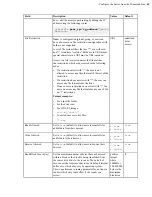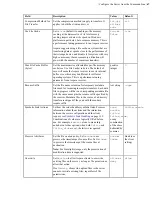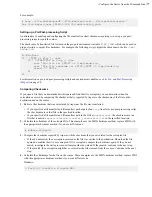
| Configure the Server from the Command Line |
62
The capacity of the Vlink is set within a
<schedule>
tag because the capacity can be scheduled as one value during
a specified time period, and a default value at all other times. For more information on this configuration, see the
knowledge base article
Specifying a time varying schedule for a Vlink
at
https://support.asperasoft.com/hc/en-us/
articles/216127698-Specifying-a-time-varying-schedule-for-a-Vlink
.
To edit
aspera.conf
manually, rather than running
asconfigurator
commands, open the file with write
permissions from the following location:
/opt/aspera/etc/aspera.conf
Validate the
aspera.conf
file using the asuserdata utility:
# /opt/aspera/bin/asuserdata -v
Increasing Transfer Performance by Using an RTT Predictor
FASP transfers use delay-based congestion control to dynamically adjust the transfer rate in response to network
congestion, as measured by round-trip time (RTT). As a result, FASP transfer stability is sensitive to feedback delay;
increases in feedback delay decrease FASP transfer stability and throughput. Transfer performance can be improved
by using two experimental configuration options, an RTT predictor and dynamic target queuing.
RTT Predictor
An RTT predictor predicts future feedback delay to decrease transfer rate oscillation and maximize data transfer under
high network congestion conditions. Four RTT predictors are available:
•
alphabeta:
A linear prediction that is based on a local trend.
•
fd31:
A linear prediction that is based on a 3-points-backwards difference method.
•
bezier:
A quadratic Bezier extrapolation.
•
ets:
An error-trend-seasonality model.
Based on internal testing, fd31 is considered the most effective and robust, but other RTT predictors might perform
better depending on your specific network conditions.
To set a predictor for incoming (transfer_in) or outgoing (transfer_out) transfers, run the following command:
# asconfigurator -x "set_node_data;transfer_{in|
out}_bandwidth_flow_network_rc_predictor,{alphabeta|bezier|ets|fd31}"
You can also set the value to
none
to force no predictor, or
unset
to use the client-specified predictor. If the client
does not specify a predictor and the server is set to
unset
, then no predictor is used.
The fd31 and bezier predictors do not have a bounded asymptotic limit, which can destabilize the RTT prediction
under conditions of high congestion and large buffer size for the transfer link. The prediction range can be restricted
by setting
<predictor_limit_range>
in
aspera.conf
.
Dynamic Target Queuing
Target queuing affects the stability of data transfer to the target. By default, Aspera FASP transfers use static target
queuing, in which the target queue is set as a piecewise function of the target rate. On noisy networks, such as satellite
and other radio communication, the congestion signal can be distorted at the physical or data link layer, and this noise
can overwhelm the congestion signal. Static target queuing has only a limited ability to adjust to this noise, decreasing
transfer performance.
Dynamic target queueing is an experimental method to improve transfer speed and stability over noisy networks.
When dynamic target queuing is enabled, the rate control module estimates the noise level and adjusts the target
queue accordingly.
















































